The relationship of DOC/CDOM
Jiwei Li1, Qian Yu1, and Yong Q. Tian2, 3
1 Department of Geosciences, University of Massachusetts, Amherst.
2 Institute for Great Lakes Research, Central Michigan University.
3 Department of Geography, Central Michigan University.
Corresponding author: Qian Yu ([email protected])
Key Points:
- The relationship of DOC/CDOM is impacted by the land cover types and temperature.
- The same CDOM indicates different DOC levels according to watershed land covers and seasons.
Abstract
The DOC flux from terrestrial to aquatic environment can be monitored at high spatial-temporal resolution through the remote sensing estimation of CDOM. To improve the reliability of DOC remote sensing monitoring, the co-variation of the DOC and CDOM were examined in a series novel mesocosm experiments and six years watershed field samplings. Both the mesocosm experiments and field samplings found the relationships of DOC/CDOM were impacted by land cover types and temperature. The same CDOM absorption represents different levels of the DOC concentration for the different vegetation (rank as evergreen, agriculture and deciduous). Meanwhile, the CDOM absorption correlated to high DOC levels in high temperature. Our findings significantly improves efficiency for using the CDOM as the DOC proxy.
1 Introduction
The terrestrially derived dissolved organic carbon (DOC) inputs a large amount of carbon (2 gigatons) to the aquatic ecosystems each year [Battin et al., 2009]. More than 1 gigaton of DOC released to the atmosphere when they are carried through the inland water systems, including the rivers, lakes, and ponds [Roulet and Moore, 2006]. Both the rivers and non-running inland waters (lakes and ponds) actively transform the DOC to the CO2 in the atmosphere [Holgerson and Raymond, 2016]. This DOC flux is the crucial components in the global greenhouse gas budget [Pachauri et al., 2015]. The input of DOC to inland water and oceans can account for considerable carbon loss from terrestrial ecosystems, which has large implications for regional carbon cycling by changing the terrestrial net ecosystem exchange [Borken et al., 2011; Kindler et al., 2011]. The terrestrial DOC inputs to the aquatic ecosystems also plays an important role in the water quality, controlling metal binding and transport, and modifying nutrients dynamics due to its labile properties in aquatic environments [Bianchi et al., 2015; Stedmon et al., 2006].
The DOC transport from land to water has remarkable implication on the carbon cycle, biogeochemical processes, and ecological processes at regional and global scale [Butman and Raymond, 2011; Raymond and Bauer, 2001; Spencer et al., 2013]. This DOC flux is required to be monitored at high spatial & temporal resolutions. However, the current studies in the DOC dynamics monitoring were generally obstructed by the discrete samples for providing the relatively sufficient spatial coverage [Fichot and Benner, 2011]. Therefore, this lateral carbon flux is often neglected in many carbon cycle budget studies [Ciais et al., 2008]. Remote sensing technology offers a compelling alternative approach to DOC monitoring through the estimation of colored dissolved organic matter (CDOM) [Brando and Dekker, 2003; Fichot and Benner, 2011; Vodacek et al., 1997]. The CDOM is the colored components of the dissolved organic matter (DOM) in the water [Del Vecchio and Blough, 2004], which changes the in-water light field through the strong absorption of short wavelength light [Rochelle-Newall and Fisher, 2002]. The CDOM absorption can be estimated through the detecting of the in-water light field to provide the high spatial-temporal resolution water carbon information [Jiwei Li, 2016].
Monitoring DOC dynamics to assess DOC flux from land to water remains a challenge. The DOC represents water biogeochemical properties and CDOM represents water bio-optical properties. Previous studies have shown field observations yield a good correlation coefficient (0.7-0.95) along each individual river plume-estuary regions [Del Castillo and Miller, 2008; Spencer et al., 2009; Vodacek et al., 1997]. In contrast, seasonal or monthly CDOM and DOC concentrations are often found decoupled across the watersheds/rivers, even though a linear relationship exists from a few studies between aggregated annual CDOM and DOC loads [Spencer et al., 2013; Tian et al., 2013]. The covariations of DOC and CDOM are rarely examined in freshwaters. The factors driving covariations of DOC and CDOM, particularly source vegetation types, are not well understood [Huang and Chen, 2009]. As a consequence, assessing DOC concentration using CDOM absorption in freshwater is subject to significant uncertainties. A better understanding of the covariation between DOC and CDOM is essential before remote sensing approaches can be routinely used to monitor DOC flux from land to water.
In this paper, we investigated the impact factors on the relationship of DOC/CDOM through the novel mesocosms experiments and six years filed samplings. The DOC productions and co-variations of DOC/CDOM were examined. The mesocosm experiments were designed as controlled conditions to separately analyze the effect of vegetation and temperature on the DOC/CDOM relationship. The seasonal DOC/CDOM variations in the different landcover watershed were also assessed. Our results showed the co-variations of DOC/CDOM were impacted by the land cover types and temperature. When the CDOM is applied as the proxy for the DOC concentration, these environmental factors needs to be concerned.
2 Materials and Methods
2.1 DOC/CDOM watershed field samplings
The Connecticut River watershed and the Chippewa River watershed were selected to measure the seasonal variations of DOC and CDOM. The drainage area of the Connecticut River encompasses 28,500 km2, where the forests cover over 79% of the entire watershed and agricultural farm covers 11% of the watershed. The Chippewa River watershed was selected to represent the agriculturally dominated watershed. The Chippewa River located in the WI states with the drainage area of 5,400 km2. The dominated land cover types were the agriculture and forest. The six study sites located in the different landcover watershed were selected in the Connecticut River watershed (Figure 1). From the March 2011 to the December 2016, bimonthly water samples were collected depending on the resource availability. A total of 150 water samples were collected in the 25 field trips in the Connecticut River. For the Chippewa River watershed, 8 study sites were selected (Figure 2). From October 2012 to May 2013, 56 water samples in 7 different months were collected.
2.2 Carbon sources and soil carbon leaching experiments
Both the carbon sources experiment and soil carbon leaching experiment were conducted in the Central Michigan University Biological Stations on Beaver Island, Lake Michigan in 2013. The 11 days carbon source experiment were processed by using six mesocosm tanks. Three dominated vegetation in Lake Michigan regions (red maple, red pine, and corn) were selected. Before the experiment, these vegetation were cleaned with DI water, and then oven dried at 60°C for 72 hours. All mesocosm tanks were filled with 180-gallon unfiltered lake water. Then the tanks were maintained under constant temperature. Each type of carbon sources (260g terrestrial vegetation) was incubated respectively under 20°C and 25°C under dark condition (Table 1). We collected daily water samples for measuring the DOC and CDOM.
The six weeks soil DOC leaching experiment is a mini-environmental ecosystem experiment with controlled situations. The controlled variables were vegetation type, temperature, soil type and artificial rainfall. Three types of leaf litters (red maple, red pine, and corn) were conducted under same weight for the results comparisons. The 65g leaf litters were selected according to the average dry weight of annual new leaf litter for Red Maple [K. A. Smemo et al., 2006]. The 10 cm depth of soil samples with O horizon and A horizon were taken from where vegetation was collected. Both the forest soils and agricultural soils were included in the experiments. The leaf litters and the soil samples were laid on top of a thin layer of gravel in the experimental mesocosm tanks (with length 0.45 m; width 0.3 m). To investigate the separate contributions to the DOC flux from leaf litter and soil organic matter, we also had bare soil without litter as the benchmark. During the experiments, soil field capacity was maintained by spraying a consistent amount of DI water daily. Each week, the 60 mm/hour artificial rainfall with 25 minutes of duration was used to derive the DOC from the mesocosm tanks. A rainfall simulator was designed to allow the intensity, duration, and distance of the rain drop to be easily varied [Bowyer-Bower and Burt, 1989]. The leachate from mesocosm tanks was collected for the DOC/CDOM analysis (including volume and concentration). A greenhouse was used to establish different mesocosm daily mean temperatures (~10 degrees). A set of replicas for each scenario were arranged for reliable measurements and for uncertainty analysis (Table 1).
All the laboratory measurements were conducted within 6 hours of each field samplings or experiments. The water samples were first filtered by GF/F glass microfiber filters (pore size 0.70 µm). Before analysis, each sample was acidified using 50 μl of 6N hydrochloric acid to remove inorganic carbon and inhibit bacterial activity. The absorbance (D) from wavelength 200 to 800 nm was measured using DU 800 Spectrophotometer. The measurements were conducted using the VWR Spectrophotometer Cell and the Milliq water as a reference. The absorption coefficient  then calculated through the measured absorbance
then calculated through the measured absorbance  Â as:
 as:
 (1)
(1)
where the  is the diameter of the cuvettes (0.01 meter). The DOC concentrations of water samples were measured through the Shimadzu TOC/V machine. To maintain instrument accuracy, internal standards and blanks were included with each instrument run.
is the diameter of the cuvettes (0.01 meter). The DOC concentrations of water samples were measured through the Shimadzu TOC/V machine. To maintain instrument accuracy, internal standards and blanks were included with each instrument run.
3 Results and Discussion
3.1 The land cover effect on the DOC production
The DOC production rates exhibit distinct patterns in the different vegetation at the carbon sources experiment and at the soil carbon leaching experiment (Figure 2, Table 1). For the equivalent weight of the carbon sources, the forest leaf litters produced higher amount of DOC compared to the agricultural crop residuals. In the carbon sources experiment, the DOC production rate ranked as the deciduous, evergreen and agriculture. In the soil carbon leaching experiment, the carbon leachate from the litters + soil was greater than the soil only. the DOC accumulative quantity ranked as the deciduous leaf litters + forest soil, evergreen leaf litters + forest soil, forest soil, agricultural corps + agricultural soil, agricultural soil.
The different decomposition rates of the vegetation affect the carbon productions in the different vegetation [Poeplau et al., 2011]. In generally, the deciduous and evergreen leaf litters have higher decomposition rate than the cornstalk and corn leaf [Fioretto et al., 2005]. The decomposition rates of the leaf litters were remarkable affected by the concentrations of the lignin [Austin and Ballaré, 2010; Gartner and Cardon, 2004]. The lignin has a dual role in affecting the litters decomposition, depending on the dominant degradation types (biotic or photo) [Austin and Ballaré, 2010]. In the photodegradation only conditions, the higher lignin concentration leads to the higher decomposition rate. So in carbon source experiment (photodegradation dominant), the DOC production from the evergreen leaf litters (medium lignin) is higher than the deciduous leaf litters (low lignin). In the soil carbon leaching experiment, the dominate degradation type was the biodegradation, so the higher lignin would lead to the lower degradation rate. The DOC leaching ranked as the deciduous (low lignin), the evergreen (medium lignin) and the agriculture (high lignin). The DOC released from the leaf litters decomposition and soil carbon leaching [Kurt A Smemo et al., 2006]. In all the mesocosm tanks, the carbon leached in the litters + soils tanks were greater than the soil only tanks. These results illustrated the leaf litters were the dominated carbon sources compared to the soil [Prescott, 2010].
3.2 The temperature effect on the DOC production
The carbon source experiment and soil carbon leaching experiment also indicated that the temperature is an important control factors for the carbon production/leaching. The DOC leachate in the high-temperature were higher than in the low-temperature. Both the leaf litters and soil produced higher carbon under the high temperature. This phenomenon was caused by the high leaf litters decomposition rate and high soil microbial respiration under the high temperature [Davidson and Janssens, 2006; Gulis and Suberkropp, 2003; Martínez et al., 2014]. Therefore, the change of the climate will have remarkable impacts on the carbon leaching from forest and agriculture litters [Dang et al., 2009]. There is concern that global warming could result in a long-term loss of soil carbon stocks [Bellamy et al., 2005; Schuur et al., 2015].
The experiments also showed the temperature effect on carbon production is varying in the different vegetation. In the 5 °C temperature difference of the carbon sources experiment, the deciduous leaf litters show more distinction pattern by comparing high and low temperature conditions than the evergreen litters and agriculture litters. The DOC concentration of the high-temperature deciduous was ~45% higher than the low-temperature deciduous. Meanwhile, the differences of evergreen (10%) and agricultural (6%) were not significant. In the soil carbon leaching experiment, the differences of DOC leachate in response to the 10 °C different temperature was more obvious in leaf litters (deciduous 57%, evergreen 45%, agriculture 48%) than in the soil (forest soil 33 %, agricultural soil 33%). These results would provide the knowledge for the terrestrial carbon budget [Houghton et al., 2012]. The DOC leaching in response to the temperature increases will have higher DOC leaching rate in the forest than in the agricultural farmland. It is worth to mentions the results comparisons were conducted at the same amount of the leaf litters in this study. The DOC leaching in the reals watershed needs to corporate with the biomass [Cornwell et al., 2008].
3.3 The co-variations of DOC and CDOM from experiments and field observations.
The examination of DOC/CDOM relationship can improve the reliability for applying the CDOM as the DOC indicator. Both the co-variations of the DOC/CDOM in the carbon sources experiment and the soil carbon leaching experiment showed the DOC/CDOM relationship were affected by the vegetation sources and temperature. The distinct slopes of the DOC/CDOM relationships in different carbon sources were showed in carbon source experiment (Figure 3). The results clearly indicated the same CDOM absorption represents different levels of DOC concentrations for the different vegetation. The slope patterns ranked as the evergreen litters, agricultural crop residuals, and deciduous litters. Meanwhile, the relationship of the DOC/CDOM is better in the high temperature than in the low temperature. The R2 of the DOC/CDOM relationship of deciduous high temperature, evergreen high temperature and agriculture high temperature were 0.97, 0.95 and 0.77.
In the soil carbon leaching experiment, the relationship slope patterns of DOC/CDOM ranked as the evergreen litters + forest soil, agriculture crops residuals + agricultural soil and deciduous litters + forest soil. Compared to the carbon sources experiment, the carbon leachates from the soils disturbed the DOC/CDOM relationship. For example, the DOC/CDOM exhibited the negative relationship in the agricultural soil in low-temperature. The R2was higher in the litters + soils than the soils only (e.g. deciduous low temp R2 = 0.82 vs forest soil low temp R2 = 0.39; deciduous high temp R2= 0.88 vs forest soil high temp R2= 0.24). The phenomenon indicated the more reliable relationship of DOC/CDOM were in the leaf litters than in the soil.
The seasonal co-variations of DOC/CDOM in the different watershed followed the same patterns of the experiments (Figure 5). In the agricultural watershed regions, the high percentage of the agricultural farmland had the high DOC/CDOM slope (Figure 5a). The evergreen dominated forest watershed had a higher slope of DOC/CDOM than the deciduous-dominated forest watershed (Figure 5b). The slopes of DOC/CDOM in the field samplings could rank as the high percentage of farmland, low percentage of farmland, evergreen and deciduous. Meanwhile, the relationship of DOC/CDOM also has similar seasonal patterns in both the agricultural watershed and forest watershed (Figure 6). The slopes of the DOC/CDOM were higher in the summer/fall than in the spring/winter.
3.4 The multiple forcing factors on the DOC/CDOM relationship
The experimental results and field samplings data indicated the relationship of DOC/CDOM is affected by leaf litters decomposition rates, the colors of the vegetation, temperature and soils. In this study, the decompositions rates of three leaf litters could rank as deciduous leaf litters, evergreen leaf litters and agricultural crops residuals [Cornwell et al., 2008]. The high decomposition rates of the leaf litters generally caused the high CDOM absorption with the same DOC concentration. The colors of different vegetation types also impacted the CDOM/DOC relationship due to the different colors of the leachate. The color of the leachate was dark brown in the forest litters and was the light brown in the agriculture litters. The CDOM levels were measured as the absorption of light in the water [Del Castillo and Miller, 2008]. Therefore, different leachate colors have different impact on the light when the DOC were the same [Brezonik et al., 2015]. The temperature affects the DOC/CDOM relationship through its effect on the decomposition rate of the leaf litters [Bothwell et al., 2014; Martínez et al., 2014]. The high temperature generally caused the high slope of DOC/CDOM relationship. These could explain the slope patterns of the DOC/CDOM were higher in the summer & the fall than in the spring & the winter. The soil is also important factors on the relationship of DOC/CDOM. The DOC/CDOM didn’t have a good relationship in the soil only experiment. The carbon leaching from the relatively non-decomposed plant residues and mineral matters in the surface soil which didn’t follow the same DOC/CDOM relationship as leaf litters [Cotrufo et al., 2013; Kim et al., 2014]. So in winters, the DOC/CDOM relationship in the forest watershed was negative due to the lack of the vegetation carbon sources. All these impact factors on the DOC/CDOM relationship need to be considered when applying the CDOM as the DOC proxy.
4 Conclusions
Successfully DOC flux monitoring through the remote sensing technology needs the examination of the DOC/CDOM relationship. In this study, the mesocosms experiments and the long-term field samplings have been conducted to study the DOC production and DOC/CDOM co-variations. The DOC leaching was affected by the vegetation types and temperature. The DOC production/leaching ranked as the deciduous, evergreen, agriculture at same quantity of leaf litters. We also found the relationship of DOC/CDOM were impacted by the land cover and temperature. For the same CDOM levels, the DOC levels in different vegetation ranked as evergreen, agricultural and deciduous. Meanwhile, the relationship of the DOC/CDOM in soil carbon was not as good as the leaf litters carbon. For the temperature effect, the same CDOM absorption indicated higher DOC levels in the higher temperature. These findings help to better applying the CDOM as the proxy for the DOC.
Acknowledgments
This research is supported by two collaborative grants from the National Science Foundation (Grant #: 1025547; Grant #: 1230261).
References
Austin, A. T., and C. L. Ballaré (2010), Dual role of lignin in plant litter decomposition in terrestrial ecosystems, Proceedings of the National Academy of Sciences, 107(10), 4618-4622.
Battin, T. J., S. Luyssaert, L. A. Kaplan, A. K. Aufdenkampe, A. Richter, and L. J. Tranvik (2009), The boundless carbon cycle, Nature Geoscience, 2(9), 598-600.
Bellamy, P. H., P. J. Loveland, R. I. Bradley, R. M. Lark, and G. J. Kirk (2005), Carbon losses from all soils across England and Wales 1978-2003, Nature, 437(7056), 245-248.
Bianchi, T. S., D. C. Thornton, S. A. Yvonâ€Lewis, G. M. King, T. I. Eglinton, M. R. Shields, N. D. Ward, and J. Curtis (2015), Positive priming of terrestrially derived dissolved organic matter in a freshwater microcosm system, Geophysical research letters, 42(13), 5460-5467.
Borken, W., B. Ahrens, C. Schulz, and L. Zimmermann (2011), Siteâ€toâ€site variability and temporal trends of DOC concentrations and fluxes in temperate forest soils, Global Change Biology, 17(7), 2428-2443.
Bothwell, L. D., P. C. Selmants, C. P. Giardina, and C. M. Litton (2014), Leaf litter decomposition rates increase with rising mean annual temperature in Hawaiian tropical montane wet forests, PeerJ, 2, e685.
Bowyer-Bower, T. A. S., and T. P. Burt (1989), Rainfall simulators for investigating soil response to rainfall, Soil Technology, 2, 1-16.
Brando, V. E., and A. G. Dekker (2003), Satellite hyperspectral remote sensing for estimating estuarine and coastal water quality, Geoscience and Remote Sensing, IEEE Transactions on, 41(6), 1378-1387.
Brezonik, P. L., L. G. Olmanson, J. C. Finlay, and M. E. Bauer (2015), Factors affecting the measurement of CDOM by remote sensing of optically complex inland waters, Remote sensing of Environment, 157, 199-215.
Butman, D., and P. A. Raymond (2011), Significant efflux of carbon dioxide from streams and rivers in the United States, Nature Geoscience, 4(12), 839-842.
Ciais, P., A. Borges, G. Abril, M. Meybeck, G. Folberth, D. Hauglustaine, and I. Janssens (2008), The impact of lateral carbon fluxes on the European carbon balance, Biogeosciences, 5(5), 1259-1271.
Cornwell, W. K., J. H. Cornelissen, K. Amatangelo, E. Dorrepaal, V. T. Eviner, O. Godoy, S. E. Hobbie, B. Hoorens, H. Kurokawa, and N. Pérezâ€Harguindeguy (2008), Plant species traits are the predominant control on litter decomposition rates within biomes worldwide, Ecology Letters, 11(10), 1065-1071.
Cotrufo, M. F., M. D. Wallenstein, C. M. Boot, K. Denef, and E. Paul (2013), The Microbial Efficiencyâ€Matrix Stabilization (MEMS) framework integrates plant litter decomposition with soil organic matter stabilization: do labile plant inputs form stable soil organic matter?, Global Change Biology, 19(4), 988-995.
Dang, C. K., M. Schindler, E. Chauvet, and M. O. Gessner (2009), Temperature oscillation coupled with fungal community shifts can modulate warming effects on litter decomposition, Ecology, 90(1), 122-131.
Davidson, E. A., and I. A. Janssens (2006), Temperature sensitivity of soil carbon decomposition and feedbacks to climate change, Nature, 440(7081), 165-173.
Del Castillo, C. E., and R. L. Miller (2008), On the use of ocean color remote sensing to measure the transport of dissolved organic carbon by the Mississippi River Plume, Remote sensing of Environment, 112(3), 836-844.
Del Vecchio, R., and N. V. Blough (2004), Spatial and seasonal distribution of chromophoric dissolved organic matter and dissolved organic carbon in the Middle Atlantic Bight, Marine Chemistry, 89(1), 169-187.
Fichot, C. G., and R. Benner (2011), A novel method to estimate DOC concentrations from CDOM absorption coefficients in coastal waters, Geophysical research letters, 38(3).
Fioretto, A., C. Di Nardo, S. Papa, and A. Fuggi (2005), Lignin and cellulose degradation and nitrogen dynamics during decomposition of three leaf litter species in a Mediterranean ecosystem, Soil Biology and Biochemistry, 37(6), 1083-1091.
Gartner, T. B., and Z. G. Cardon (2004), Decomposition dynamics in mixedâ€species leaf litter, Oikos, 104(2), 230-246.
Gulis, V., and K. Suberkropp (2003), Leaf litter decomposition and microbial activity in nutrientâ€enriched and unaltered reaches of a headwater stream, Freshwater biology, 48(1), 123-134.
Holgerson, M. A., and P. A. Raymond (2016), Large contribution to inland water CO2 and CH4 emissions from very small ponds, Nature Geoscience.
Houghton, R. A., J. House, J. Pongratz, G. Van der Werf, R. DeFries, M. Hansen, C. L. Quéré, and N. Ramankutty (2012), Carbon emissions from land use and land-cover change, Biogeosciences, 9(12), 5125-5142.
Huang, W., and R. F. Chen (2009), Sources and transformations of chromophoric dissolved organic matter in the Neponset River Watershed, Journal of Geophysical Research: Biogeosciences (2005-2012), 114(G4).
Jiwei Li, Q. Y., Yong Q. Tian, Brian L. Becker (2016), Remote Sensing Estimation of Colored Dissolved Organic Matter (CDOM) in Optically Shallow Waters ISPRS Journal of Photogrammetry and Remote Sensing (in revision).
Kim, Y., S. Ullah, T. R. Moore, and N. T. Roulet (2014), Dissolved organic carbon and total dissolved nitrogen production by boreal soils and litter: the role of flooding, oxygen concentration, and temperature, Biogeochemistry, 118(1-3), 35-48.
Kindler, R., J. Siemens, K. Kaiser, D. C. Walmsley, C. Bernhofer, N. Buchmann, P. Cellier, W. Eugster, G. Gleixner, and T. GRŨNWALD (2011), Dissolved carbon leaching from soil is a crucial component of the net ecosystem carbon balance, Global Change Biology, 17(2), 1167-1185.
Martínez, A., A. Larrañaga, J. Pérez, E. Descals, and J. Pozo (2014), Temperature affects leaf litter decomposition in low-order forest streams: field and microcosm approaches, FEMS microbiology ecology, 87(1), 257-267.
Pachauri, R. K., L. Meyer, G.-K. Plattner, and T. Stocker (2015), IPCC, 2014: Climate Change 2014: Synthesis Report. Contribution of Working Groups I, II and III to the Fifth Assessment Report of the Intergovernmental Panel on Climate Change, IPCC.
Poeplau, C., A. Don, L. Vesterdal, J. Leifeld, B. Van Wesemael, J. Schumacher, and A. Gensior (2011), Temporal dynamics of soil organic carbon after landâ€use change in the temperate zone-carbon response functions as a model approach, Global Change Biology, 17(7), 2415-2427.
Prescott, C. E. (2010), Litter decomposition: what controls it and how can we alter it to sequester more carbon in forest soils?, Biogeochemistry, 101(1-3), 133-149.
Raymond, P. A., and J. E. Bauer (2001), Riverine export of aged terrestrial organic matter to the North Atlantic Ocean, Nature, 409(6819), 497-500.
Rochelle-Newall, E., and T. Fisher (2002), Chromophoric dissolved organic matter and dissolved organic carbon in Chesapeake Bay, Marine Chemistry, 77(1), 23-41.
Roulet, N., and T. R. Moore (2006), Environmental chemistry: Browning the waters, Nature, 444(7117), 283-284.
Schuur, E., A. McGuire, C. Schädel, G. Grosse, J. Harden, D. Hayes, G. Hugelius, C. Koven, P. Kuhry, and D. Lawrence (2015), Climate change and the permafrost carbon feedback, Nature, 520(7546), 171-179.
Smemo, K. A., D. R. Zak, and K. S. Pregitzer (2006), Chronic experimental deposition reduces the retention of leaf litter DOC in a northern hardwood forest soil, Soil Biology and Biochemistry, 38(6), 1340-1347.
Smemo, K. A., D. R. Zak, and K. S. Pregitzer (2006), Chronic experimental NO3- deposition reduces the retention of leaf litter DOC in a northern hardwood forest soil, Soil Biol Biochem, 38(6), 1340-1347.
Spencer, R. G., G. R. Aiken, K. D. Butler, M. M. Dornblaser, R. G. Striegl, and P. J. Hernes (2009), Utilizing chromophoric dissolved organic matter measurements to derive export and reactivity of dissolved organic carbon exported to the Arctic Ocean: A case study of the Yukon River, Alaska, Geophysical research letters, 36(6).
Spencer, R. G., G. R. Aiken, M. M. Dornblaser, K. D. Butler, R. M. Holmes, G. Fiske, P. J. Mann, and A. Stubbins (2013), Chromophoric dissolved organic matter export from US rivers, Geophysical research letters, 40(8), 1575-1579.
Stedmon, C. A., S. Markager, M. Søndergaard, T. Vang, A. Laubel, N. H. Borch, and A. Windelin (2006), Dissolved organic matter (DOM) export to a temperate estuary: seasonal variations and implications of land use, Estuaries and Coasts, 29(3), 388-400.
Tian, Y. Q., Q. Yu, A. D. Feig, C. Ye, and A. Blunden (2013), Effects of climate and land-surface processes on terrestrial dissolved organic carbon export to major US coastal rivers, Ecological Engineering, 54, 192-201.
Vodacek, A., N. V. Blough, M. D. DeGrandpre, E. T. Peltzer, and R. K. Nelson (1997), Seasonal variation of CDOM and DOC in the Middle Atlantic Bight: Terrestrial inputs and photooxidation, Limnology and Oceanography, 42(4), 674-686.
Table 1. The carbon source and soil carbon leaching experiments setting
|
Carbon source |
Vegetation |
Temp (°C) |
Tank used |
DOC (mg/L) |
|
Deciduous |
20 |
1 |
24.13 |
|
|
Deciduous |
25 |
1 |
28.5 |
|
|
Evergreen |
20 |
1 |
26.43 |
|
|
Evergreen |
25 |
1 |
21.91 |
|
|
Agriculture |
20 |
1 |
12.14 |
|
|
Agriculture |
25 |
1 |
12.62 |
|
|
Soil carbon leaching |
Vegetation |
Temp (°C) |
Tank used |
DOC (g/m2) |
|
Deciduous + forest soil |
Outdoor |
3 |
5.32 |
|
|
Deciduous + forest soil |
Outdoor + 10 |
3 |
12.91 |
|
|
Evergreen + forest soil |
Outdoor |
3 |
4.76 |
|
|
Evergreen + forest soil |
Outdoor + 10 |
3 |
8.94 |
|
|
Forest soil |
Outdoor |
2 |
3.42 |
|
|
Forest soil |
Outdoor + 10 |
2 |
6.77 |
|
|
Agriculture + Agriculture soil |
Outdoor |
3 |
2.09 |
|
|
Agriculture + Agriculture soil |
Outdoor + 10 |
3 |
4.18 |
|
|
Agriculture soil |
Outdoor |
2 |
1.93 |
|
|
Agriculture soil |
Outdoor + 10 |
2 |
2.98 |
Figure 1
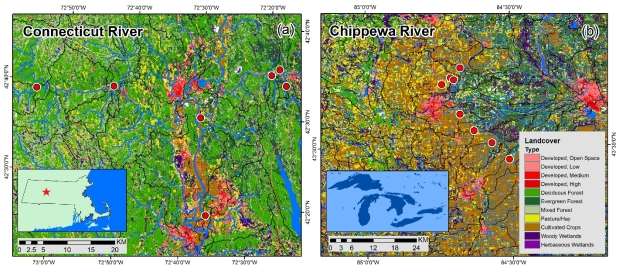
Figure 1. The field sampling sites in the Connecticut River watershed (Figure 1a) and in the Chippewa River watershed (Figure 1b). Three sampling sites located in the west Connecticut River watershed were dominated by deciduous forest (deciduous 50%, evergreen 10%, and mixed forest 28%). The east three samplings sites in the Connecticut River watershed were dominated by the evergreen forest (evergreen 42%, deciduous 31%, and mixed forest 18%). The single south sampling sites in the Connecticut River watershed was the agricultural crops sites (agriculture 35% and deciduous 25%). The eight sampling sites in the Chippewa River watershed were all dominated by the agricultural corps (agriculture 72% and deciduous 8%).
Figure 2
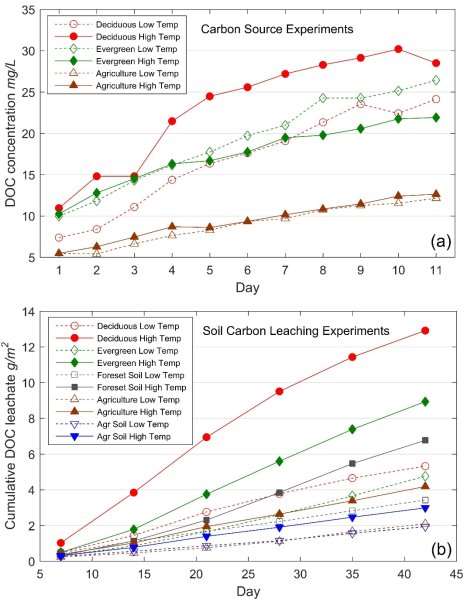
Figure 2. The carbon production results in the carbon source experiment (a) and in the soil carbon leaching experiment (b). The DOC concentrations in different vegetation carbon source tanks were plotted in Figure 2a. The cumulative DOC leachate quantity per square meter from soil carbon leaching experiments were plotted in Figure 2b. The high temperature generally leads to the high DOC production/leaching rates. The carbon leaching rate in different vegetation were also different in the same weight of leaf litters.
Figure 3
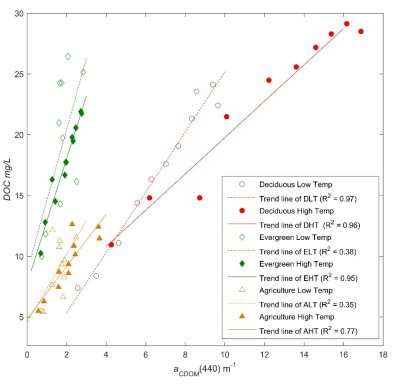
Figure 3. The DOC/CDOM variations during the mesocosms carbon sources experiment. The DOC/CDOM relationship have different patterns according to the vegetation types and the temperatures.
Figure 4
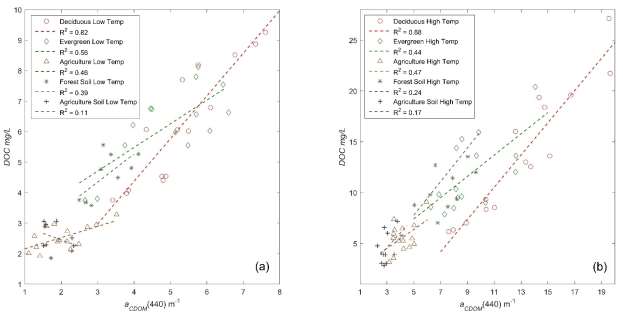
Figure 4. The CDOM/CDOM co-variations in the soil leaching experiments under low temperature (Figure 4a) and high temperature (Figure 4b). The DOC/CDOM were more correlated in the leaf litters + soils than the soils only.
Figure 5
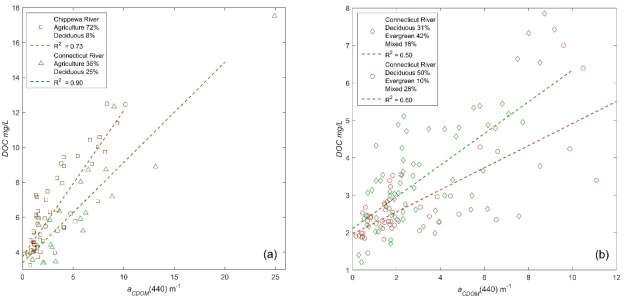
Figure 5. The co-variations of DOC/CDOM in the agricultural watershed (Figure 5a) and in the forest watershed (Figure 5b). The co-variations of DOC/CDOM had different trends in the different land cover types. The same CDOM absorption represented different levels of DOC concentrations in different watershed (rank as high percentage of farmland, low percentage of farmland, evergreen and deciduous).
Figure 6
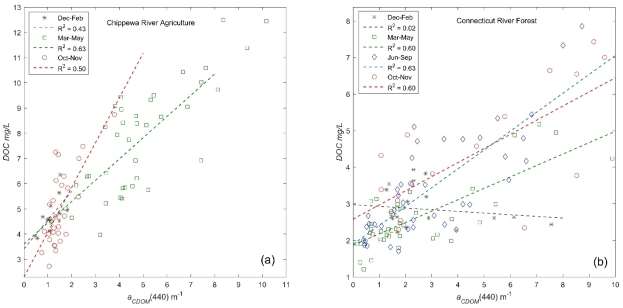
Figure 6. The seasonal co-variations of the DOC/CDOM in the Chippewa River agricultural watershed (Figure 6a) and the Connecticut River forest watershed (Figure 6b). The relationship of the DOC/CDOM were not good in the winter due to the lack of the active carbon sources. The same CDOM absorption represents different levels of DOC in different seasons (fall/summer > winter/spring).